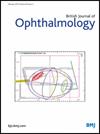Preperimetric glaucoma: conversion to primary open-angle glaucoma in a 10-year follow-up.
IF 3.5
2区 医学
Q1 OPHTHALMOLOGY
引用次数: 0
Abstract
BACKGROUND/AIMS To investigate the clinical course of preperimetric open-angle glaucoma (PPG) over follow-up period exceeding 10 years and to identify factors associated with conversion to primary open-angle glaucoma (POAG). METHODS A total of 124 eyes from 124 PPG patients, followed for more than 10 years, were included. Progression was defined as either structural or functional deterioration. Cox proportional hazard modelling was employed to identify factors for progression. Kaplan-Meier survival analysis was used to compare cumulative progression probability in PPG patients with or without optic disc haemorrhage (DH). RESULTS Among the PPG subjects included, 44 eyes (35.5%) converted to POAG, with a mean deviation change of -0.39±0.64 dB/year over a mean follow-up of 12.2±4.2 years. The mean time to conversion was 5.3±2.2 years. Within the conversion group, 30 eyes (68.2%) exhibited functional progression, 23 eyes (52.3%) showed structural progression and nine eyes (20.5%) demonstrated both. Factors significantly associated with glaucoma progression were migraine/headache (HR=2.19, p=0.012), reduction of intraocular pressure (IOP; HR=0.75, p=0.009), and disc haemorrhage (DH; HR=3.78, p<0.001). Notably, patients with DH exhibited higher cumulative probability of progression compared with those without DH (p=0.017). CONCLUSIONS This study of PPG with more than 10 years of follow-up demonstrates a substantial proportion (35.5%) converting to POAG, highlighting the need for long-term monitoring in these patients. PPG with insufficient IOP reduction and DH was associated with significantly higher cumulative probability of progression, emphasising its prognostic significance in PPG patients.围周前青光眼:10年随访转为原发性开角型青光眼。
背景/目的:在超过10年的随访期间,研究预周距开角型青光眼(PPG)的临床病程,并确定与原发性开角型青光眼(POAG)转化相关的因素。方法选取124例PPG患者124只眼,随访10年以上。进展被定义为结构或功能恶化。采用Cox比例风险模型确定影响进展的因素。Kaplan-Meier生存分析用于比较伴有或不伴有视盘出血(DH)的PPG患者的累积进展概率。结果PPG患者中有44只眼(35.5%)转化为POAG,平均偏差变化为-0.39±0.64 dB/年,平均随访12.2±4.2年。平均转化时间为5.3±2.2年。在转换组中,30只眼(68.2%)表现为功能进展,23只眼(52.3%)表现为结构进展,9只眼(20.5%)均表现为功能进展。与青光眼进展显著相关的因素是偏头痛/头痛(HR=2.19, p=0.012)、眼压降低(IOP; HR=0.75, p=0.009)和椎间盘出血(DH; HR=3.78, p<0.001)。值得注意的是,与没有DH的患者相比,DH患者表现出更高的累积进展概率(p=0.017)。本研究对PPG进行了超过10年的随访,结果显示有相当大比例(35.5%)的患者转化为POAG,这突出了对这些患者进行长期监测的必要性。IOP降低和DH不足的PPG与进展的累积概率显著升高相关,强调其在PPG患者中的预后意义。
本文章由计算机程序翻译,如有差异,请以英文原文为准。
求助全文
约1分钟内获得全文
求助全文
来源期刊
CiteScore
10.30
自引率
2.40%
发文量
213
审稿时长
3-6 weeks
期刊介绍:
The British Journal of Ophthalmology (BJO) is an international peer-reviewed journal for ophthalmologists and visual science specialists. BJO publishes clinical investigations, clinical observations, and clinically relevant laboratory investigations related to ophthalmology. It also provides major reviews and also publishes manuscripts covering regional issues in a global context.

 求助内容:
求助内容: 应助结果提醒方式:
应助结果提醒方式:


